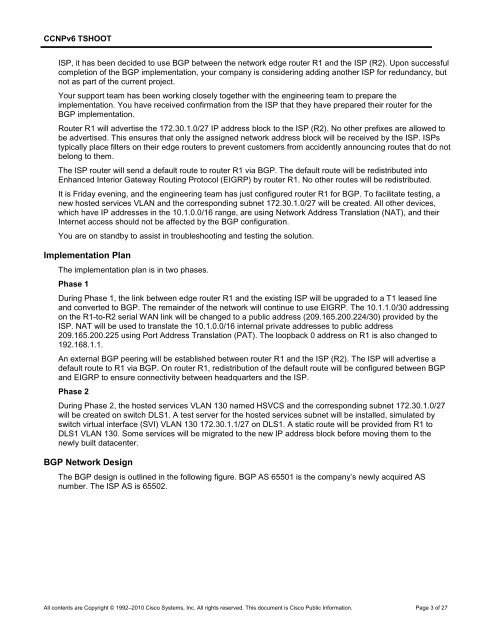CCNP TSHOOT 6.0 - The Cisco Learning Network
CCNP TSHOOT 6.0 - The Cisco Learning Network
CCNP TSHOOT 6.0 - The Cisco Learning Network
You also want an ePaper? Increase the reach of your titles
YUMPU automatically turns print PDFs into web optimized ePapers that Google loves.
<strong>CCNP</strong>v6 <strong>TSHOOT</strong><br />
ISP, it has been decided to use BGP between the network edge router R1 and the ISP (R2). Upon successful<br />
completion of the BGP implementation, your company is considering adding another ISP for redundancy, but<br />
not as part of the current project.<br />
Your support team has been working closely together with the engineering team to prepare the<br />
implementation. You have received confirmation from the ISP that they have prepared their router for the<br />
BGP implementation.<br />
Router R1 will advertise the 172.30.1.0/27 IP address block to the ISP (R2). No other prefixes are allowed to<br />
be advertised. This ensures that only the assigned network address block will be received by the ISP. ISPs<br />
typically place filters on their edge routers to prevent customers from accidently announcing routes that do not<br />
belong to them.<br />
<strong>The</strong> ISP router will send a default route to router R1 via BGP. <strong>The</strong> default route will be redistributed into<br />
Enhanced Interior Gateway Routing Protocol (EIGRP) by router R1. No other routes will be redistributed.<br />
It is Friday evening, and the engineering team has just configured router R1 for BGP. To facilitate testing, a<br />
new hosted services VLAN and the corresponding subnet 172.30.1.0/27 will be created. All other devices,<br />
which have IP addresses in the 10.1.0.0/16 range, are using <strong>Network</strong> Address Translation (NAT), and their<br />
Internet access should not be affected by the BGP configuration.<br />
You are on standby to assist in troubleshooting and testing the solution.<br />
Implementation Plan<br />
<strong>The</strong> implementation plan is in two phases.<br />
Phase 1<br />
During Phase 1, the link between edge router R1 and the existing ISP will be upgraded to a T1 leased line<br />
and converted to BGP. <strong>The</strong> remainder of the network will continue to use EIGRP. <strong>The</strong> 10.1.1.0/30 addressing<br />
on the R1-to-R2 serial WAN link will be changed to a public address (209.165.200.224/30) provided by the<br />
ISP. NAT will be used to translate the 10.1.0.0/16 internal private addresses to public address<br />
209.165.200.225 using Port Address Translation (PAT). <strong>The</strong> loopback 0 address on R1 is also changed to<br />
192.168.1.1.<br />
An external BGP peering will be established between router R1 and the ISP (R2). <strong>The</strong> ISP will advertise a<br />
default route to R1 via BGP. On router R1, redistribution of the default route will be configured between BGP<br />
and EIGRP to ensure connectivity between headquarters and the ISP.<br />
Phase 2<br />
During Phase 2, the hosted services VLAN 130 named HSVCS and the corresponding subnet 172.30.1.0/27<br />
will be created on switch DLS1. A test server for the hosted services subnet will be installed, simulated by<br />
switch virtual interface (SVI) VLAN 130 172.30.1.1/27 on DLS1. A static route will be provided from R1 to<br />
DLS1 VLAN 130. Some services will be migrated to the new IP address block before moving them to the<br />
newly built datacenter.<br />
BGP <strong>Network</strong> Design<br />
<strong>The</strong> BGP design is outlined in the following figure. BGP AS 65501 is the company’s newly acquired AS<br />
number. <strong>The</strong> ISP AS is 65502.<br />
All contents are Copyright © 1992–2010 <strong>Cisco</strong> Systems, Inc. All rights reserved. This document is <strong>Cisco</strong> Public Information. Page 3 of 27

















